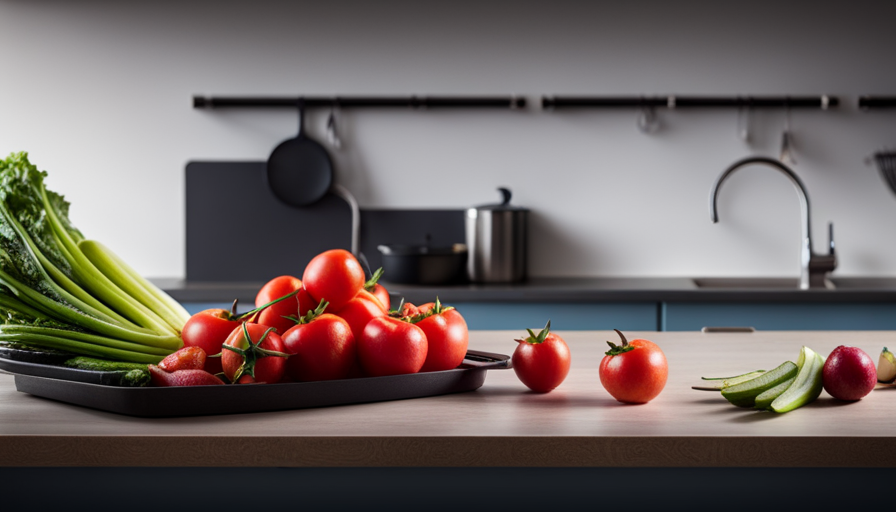Can you capture the essence of a painting with just one brushstroke on a beautiful, untouched canvas?
This metaphor represents the debate between raw and cooked food. While raw food enthusiasts argue that the natural state of food is the most beneficial for our health, cooking adds depth and complexity to our meals.
In this article, we’ll explore the reasons why cooking food is not only acceptable but also essential for a balanced diet. From enhancing flavors and textures to eliminating harmful bacteria, cooking offers a multitude of benefits. However, it’s important to find a balance between raw and cooked foods to ensure we meet our individual dietary needs and goals.
So, let’s dive into the world of raw and cooked food and discover the artistry of culinary choices.
Key Takeaways
- Raw food enthusiasts argue that the natural state of food is beneficial for health, while cooking adds depth and complexity to meals.
- Cooking food enhances flavors, textures, and nutritional accessibility, and can eliminate harmful bacteria and parasites, reducing the risk of foodborne illnesses.
- Raw food provides enzymes that aid in digestion, while cooking above 118 degrees Fahrenheit can destroy these enzymes.
- Incorporating both raw and cooked foods into the diet ensures a balanced intake of nutrients and reduces the risk of foodborne illnesses.
Nutritional Benefits of Raw Food
You’ll be amazed at the incredible nutritional benefits you can get from eating raw food! When it comes to enzymes and digestion, raw food is a powerhouse. Enzymes are essential for breaking down food and aiding in digestion, and they are abundant in raw fruits, vegetables, and nuts. Cooking food above 118 degrees Fahrenheit can destroy these enzymes, which means that raw food provides a natural source of digestive support that cooked food may lack.
Raw food also helps to prevent the growth of harmful bacteria. Cooking food can kill off bacteria that may be present, but it’s not foolproof. Some bacteria can survive high temperatures and remain in cooked food. On the other hand, raw food is less likely to harbor harmful bacteria, as the natural enzymes and nutrients in raw food have antimicrobial properties. So by eating raw food, you’re reducing the risk of foodborne illnesses.
However, it’s important to note that not all foods are suitable for raw consumption. Some foods, like meat and eggs, can carry harmful bacteria that can only be killed through cooking. It’s crucial to practice safe food handling and preparation when it comes to raw food, especially when dealing with potentially risky ingredients.
Raw food offers numerous nutritional benefits, particularly in terms of enzymes and digestion, as well as reducing the risk of harmful bacteria. It’s important to strike a balance and choose the right foods to eat raw while taking necessary precautions to ensure food safety.
Enzymes and Digestive Health
Savor the rich flavors and embrace the vibrant energy of unadulterated nourishment, as the uncooked essence of your meal harmonizes with the natural enzymes in your body, invigorating your digestive health. Raw food enthusiasts argue that cooking can destroy these vital enzymes, leading to compromised digestion and nutrient absorption. While some research suggests that cooking can indeed reduce enzyme levels in food, the impact on overall digestion and health is not yet fully understood.
Enzymes play a crucial role in breaking down food into smaller, more easily absorbed molecules. Proponents of raw food claim that consuming enzymes from uncooked foods can boost digestive health and alleviate common digestive issues such as bloating and indigestion. However, it’s important to note that our bodies also produce their own enzymes to aid in digestion. The digestive system is highly efficient at adapting to a variety of diets, whether raw or cooked.
Moreover, while raw food may contain higher levels of certain enzymes, it does not necessarily translate to weight loss. Weight loss is a complex process that involves many factors, such as calorie intake, portion control, and overall dietary balance. Simply consuming raw food does not guarantee weight loss or immune system enhancement.
To provide a balanced perspective, it’s essential to consider that cooking can also have its benefits. Cooking can enhance the flavors, textures, and nutritional accessibility of certain foods. Heat can break down cell walls, making nutrients more bioavailable and easily absorbed by the body. Additionally, cooking helps eliminate harmful bacteria and parasites that may be present in raw food, reducing the risk of foodborne illnesses.
While raw food proponents emphasize the potential benefits of enzymes and its effect on digestion, the overall impact on digestive health and immune system function is still not fully understood. Incorporating a variety of both raw and cooked foods into your diet can ensure a balanced intake of nutrients and reduce the risk of foodborne illnesses. Remember, it’s always important to listen to your body and consult with a healthcare professional or registered dietitian before making any significant changes to your diet.
| Enzymes and Weight Loss | Raw Food and Immune System | Cooking Benefits |
|---|---|---|
| Raw food enthusiasts believe that the enzymes present in uncooked food can aid in weight loss. However, weight loss is a complex process influenced by various factors. | Raw food is believed to support the immune system due to its high nutrient content. However, a balanced diet that includes cooked food can also provide essential nutrients for immune function. | Cooking certain foods can enhance flavors, textures, and nutrient accessibility. Heat can also eliminate harmful bacteria and parasites, reducing the risk of foodborne illnesses. |
Cooking Methods and Their Effects on Nutrients
Experience the mouthwatering transformation that occurs when ingredients are heated, as different cooking methods can either enhance or diminish the nutritional value of your meal. Understanding various cooking techniques is essential to ensure optimal nutrient retention in your food.
Here are three cooking methods and their effects on nutrient retention:
-
Steaming: This gentle cooking method involves cooking food over boiling water. Steaming helps retain water-soluble vitamins like vitamin C and B vitamins, which can be lost through other cooking methods. It also preserves the vibrant colors and natural flavors of vegetables.
-
Grilling: Grilling adds a delicious smoky flavor to food, but it can cause some nutrient loss. High heat can break down certain vitamins, such as vitamin C. However, grilling can help retain other nutrients like protein and minerals. To minimize nutrient loss, marinate your food before grilling and avoid charring.
-
Stir-frying: This quick-cooking method involves cooking food at high heat with minimal oil. Stir-frying helps retain the nutritional value of vegetables, as they cook quickly and retain their vibrant colors and crunchiness. However, overcooking can lead to nutrient loss, so it’s important to cook vegetables until they’re just tender.
By understanding how different cooking methods affect nutrient retention, you can make informed choices to maximize the nutritional value of your meals.
Enhanced Flavor and Texture through Cooking
Get ready to tantalize your taste buds with the delectable flavors and irresistible textures that can be achieved through the art of cooking. While raw food may have its nutritional benefits, cooking can greatly enhance the overall experience of eating.
One of the key advantages of cooking is increased nutrient absorption. Heat breaks down the tough cell walls of plants and denatures proteins in meat, making it easier for your body to digest and absorb nutrients. For example, cooking tomatoes increases the availability of lycopene, a powerful antioxidant that promotes heart health.
Cooking also allows for culinary creativity. By applying heat and various cooking techniques, you can transform simple ingredients into a wide array of mouthwatering dishes. The Maillard reaction, which occurs when proteins and sugars react to heat, creates a rich flavor and appetizing aroma. Grilling a steak or roasting vegetables can bring out their natural sweetness and add depth to their taste profile.
Furthermore, cooking can alter the texture of food, making it more enjoyable to eat. Heat softens fibrous vegetables, making them easier to chew and digest. It can also produce a satisfying crispiness in foods like roasted potatoes or fried chicken. These changes in texture can greatly enhance the overall dining experience and make meals more pleasurable.
While raw food may have its merits, cooking offers a whole new world of flavors, textures, and creative possibilities. So go ahead, explore the culinary arts and enjoy the enhanced taste and texture that cooking can bring to your meals.
Eliminating Harmful Bacteria
By eliminating harmful bacteria through proper cooking techniques, you’ll be able to relish in the delightful flavors and textures of your meals without any worries. Cooking food effectively kills bacteria that can cause foodborne illnesses, making it an essential step in ensuring food safety.
Raw food can harbor harmful bacteria such as E. coli, salmonella, and listeria. These bacteria can cause severe illness, including nausea, vomiting, diarrhea, and even life-threatening conditions. Cooking food at the right temperature kills these bacteria, reducing the risk of foodborne illnesses.
Proper cooking techniques involve heating food to a specific temperature, usually above 165°F (74°C), which is the temperature at which most harmful bacteria are killed. This temperature ensures that the food is safe to consume, eliminating any potential risks.
Additionally, cooking can also destroy toxins produced by bacteria, further reducing the risk of food poisoning. Some foods, like poultry and ground meats, require thorough cooking to eliminate bacteria completely. By cooking these foods properly, you can ensure that they’re safe to eat.
While raw food enthusiasts argue that cooking destroys some nutrients, the risk of foodborne illnesses outweighs the potential loss of nutrients. By following proper cooking techniques, you can eliminate harmful bacteria and enjoy your meals with peace of mind. Remember to always practice good food safety habits to protect yourself and your loved ones.
Increased Digestibility of Certain Foods
Enhance your dining experience by savoring the increased digestibility of certain delectable dishes, allowing your taste buds to revel in the culinary delight while your stomach thanks you for the effortless breakdown of nutrients.
While raw food advocates argue that cooking destroys vital nutrients, it’s important to note that cooking can actually increase nutrient absorption in certain foods.
The raw food movement promotes the consumption of uncooked and unprocessed foods, believing that heat destroys essential enzymes and vitamins. However, research suggests that cooking certain foods can enhance their nutrient availability.
For example, cooking vegetables like tomatoes and carrots breaks down the tough cell walls, making it easier for our bodies to access and absorb the nutrients they contain. Additionally, cooking can denature proteins, making them easier to digest and absorb.
Moreover, cooking can also neutralize certain anti-nutrients present in raw foods. Anti-nutrients, such as phytic acid and lectins, can interfere with the absorption of essential minerals like iron and calcium. By cooking these foods, we can reduce the levels of anti-nutrients, making the nutrients more readily available for our bodies to absorb.
While raw foods certainly have their benefits, it’s crucial to consider the increased digestibility that cooking can provide. By incorporating both raw and cooked foods into your diet, you can maximize nutrient absorption and enjoy a well-rounded culinary experience.
Potential Health Risks of Raw Food
Indulge in the tantalizing allure of raw foods, but beware of the potential health risks that can lurk beneath their uncooked surface. While raw food enthusiasts tout the health benefits of consuming food in its natural state, it’s important to consider the potential dangers associated with raw food consumption.
-
Foodborne illnesses: Raw foods, such as raw meat, eggs, and unpasteurized milk, can harbor harmful bacteria like Salmonella, E. coli, and Listeria. These pathogens can cause severe foodborne illnesses, leading to symptoms like vomiting, diarrhea, and in some cases, even death.
-
Nutrient availability: Cooking certain foods can actually enhance the availability of nutrients. For example, cooking tomatoes increases the bioavailability of lycopene, a powerful antioxidant. Additionally, cooking can break down the cell walls of vegetables, making it easier for our bodies to absorb nutrients like beta-carotene.
-
Food safety practices: Proper cooking techniques, such as heating food to the right temperature, can help kill harmful bacteria and reduce the risk of foodborne illnesses. Cooking also helps to eliminate parasites that may be present in raw fish or meat.
While raw food consumption can offer some health benefits, it’s crucial to prioritize food safety. By practicing proper cooking techniques and being mindful of potential health risks, you can enjoy the best of both worlds – the delicious taste of raw foods and the assurance of a safe meal.
Finding Balance: Incorporating Both Raw and Cooked Foods
Strike a balance between the vibrant colors and textures of fresh, uncooked ingredients and the comforting warmth of a cooked meal, creating a harmonious fusion that satisfies both your palate and your senses. Incorporating both raw and cooked foods into your diet can provide a range of health benefits while addressing potential risks associated with consuming solely raw or cooked food.
Finding balance is key when it comes to incorporating both raw and cooked foods into your meals. While raw food enthusiasts argue that cooking destroys vital nutrients, such as enzymes and vitamins, cooking can also enhance the availability of certain nutrients and kill harmful bacteria. By combining raw and cooked foods, you can maximize the nutritional value of your meals while minimizing potential health risks.
Personal preferences and cultural practices also play a significant role in determining the balance between raw and cooked foods in your diet. Some individuals may prefer the crisp freshness of raw vegetables, while others find comfort in warm, cooked meals. Cultural practices may dictate the cooking methods and ingredients used in traditional dishes.
To better understand the benefits of both raw and cooked foods, let’s take a look at the table below:
| Raw Foods | Cooked Foods |
|---|---|
| High in enzymes | Enhanced nutrient availability |
| Retains more vitamins | Kills harmful bacteria |
| Provides fiber | Enhances flavors |
| Promotes hydration | Increases digestibility |
By incorporating a variety of raw and cooked foods into your diet, you can strike a balance that suits your personal preferences and cultural practices while reaping the health benefits of both. Remember to listen to your body and make choices that support your overall well-being.
Personal Preferences and Cultural Practices
Incorporating a variety of both raw and cooked foods into our diets allows us to honor personal preferences and cultural practices, creating a harmonious balance that supports our overall well-being.
While some people enjoy the crispness and natural flavors of raw food, others prefer the comforting warmth and enhanced flavors that cooking brings. Cultural traditions also play a significant role in determining whether food should be consumed raw or cooked.
Personal preferences for raw or cooked foods can stem from various factors, including taste preferences, texture preferences, and health beliefs. Some individuals may find raw food more appealing because it retains its natural freshness and nutritional value. On the other hand, cooking can enhance the flavors of certain foods, making them more enjoyable for those with a preference for cooked dishes.
Cultural practices also influence whether food is consumed raw or cooked. Many cuisines have traditional recipes and cooking methods that have been passed down through generations. These cultural traditions often dictate the specific ways in which certain ingredients are prepared and cooked. For example, sushi is a beloved Japanese dish that celebrates the freshness and delicate flavors of raw fish.
Ultimately, whether to eat raw or cooked food is a personal choice influenced by cultural traditions and individual preferences. Incorporating a balance of both raw and cooked foods can provide a diverse array of flavors and textures, allowing us to enjoy the best of both worlds while supporting our overall well-being.
Considering Individual Dietary Needs and Goals
Now that we have explored personal preferences and cultural practices in relation to eating raw food, let’s shift our focus to considering individual dietary needs and goals. It’s important to recognize that while raw food may offer certain health benefits, it may not be suitable for everyone.
Individuals with specific dietary restrictions, such as those with compromised immune systems or certain medical conditions, may need to avoid raw food due to the potential risk of foodborne illnesses. Cooking food can help eliminate harmful bacteria and parasites, making it safer to consume.
Additionally, for those individuals who have weight loss goals, cooking food can be advantageous. Cooking certain foods can enhance their digestibility, allowing the body to absorb nutrients more efficiently. Moreover, cooking can help break down tough fibers and make food easier to chew and digest, promoting satiety and reducing the likelihood of overeating.
To better understand the impact of cooking on different foods, let’s take a look at the following table:
| Food Item | Raw | Cooked |
|---|---|---|
| Broccoli | Crunchy | Tender |
| Chicken | Risky | Safe |
| Quinoa | Chewy | Fluffy |
| Potatoes | Hard | Soft |
| Salmon | Sushi | Grilled |
Considering individual dietary needs and weight loss goals, cooking food can provide benefits such as improved safety, enhanced nutrient absorption, and increased satiety. It’s important to find the right balance between raw and cooked foods that aligns with your personal health goals and dietary restrictions.
Frequently Asked Questions
Can raw food be just as nutritious as cooked food?
Raw food can indeed be just as nutritious as cooked food. In fact, a study published in the Journal of Agricultural and Food Chemistry found that cooking certain vegetables can lead to a loss of up to 50% of their vitamin C content. However, it’s important to note that cooking can also enhance the bioavailability of certain nutrients, like lycopene in tomatoes.
While a raw food diet can have its benefits for overall health, incorporating a mix of raw and cooked vegetables ensures a well-rounded nutritional intake.
Is it safe to eat raw meat or seafood?
Eating raw meat carries risks of foodborne illnesses such as salmonella, E. coli, and parasites like tapeworms. Raw seafood, especially shellfish, can be contaminated with bacteria and viruses, leading to infections like norovirus and hepatitis A.
Cooking meat and seafood kills harmful bacteria and parasites, making them safer to consume. While it’s important to handle and cook raw meat properly to minimize risks, cooking remains the best way to ensure food safety and prevent illnesses associated with raw meat and seafood consumption.
Are there any specific cooking methods that preserve more nutrients?
When it comes to cooking techniques that preserve more nutrients, there are a few options to consider.
Steaming is a great method as it gently cooks the food and helps retain its vitamins and minerals.
Another technique is stir-frying, which quickly cooks the ingredients while maintaining their nutritional value.
Roasting and grilling are also good choices, as they can enhance the flavors while minimizing nutrient loss.
Ultimately, it’s important to choose cooking methods that balance taste and nutrient retention.
How does cooking enhance the flavor and texture of food?
Cooking enhances the flavor and texture of food by breaking down complex molecules, making them more easily digestible and releasing aromas that stimulate our taste buds.
Heat alters the chemical structure of food, intensifying flavors and creating new ones through the Maillard reaction.
Additionally, cooking can improve the mouthfeel of food by softening tough fibers and adding desirable textures like crispy or creamy.
Thus, cooking not only makes food safer to eat, but it also enhances taste and improves mouthfeel, providing a more enjoyable culinary experience.
Can certain raw foods be difficult to digest for some individuals?
Did you know that approximately 20% of people suffer from food allergies or intolerances? This statistic highlights the importance of understanding how certain raw foods can be difficult to digest for some individuals.
Raw foods like fruits, vegetables, and nuts contain enzymes that can be challenging for some people to break down, leading to digestive discomfort. Additionally, raw foods can also trigger allergic reactions in those with specific food allergies.
It’s crucial to consider individual differences and potential digestive issues when consuming raw foods.
Why Is Raw Milk Considered Unsafe to Consume, Despite the Appeal of Eating Raw Food?
Many health experts consider raw milk off limits due to the potential risks of harmful bacteria like E. coli and Salmonella. Despite the appeal of consuming raw food, the dangers associated with raw milk make it unsafe for consumption, leading authors to caution against its consumption.
Conclusion
In conclusion, when it comes to the debate of raw food versus cooked food, it’s important to find a balance that suits your individual needs.
While raw food may offer nutritional benefits and enzymes for digestive health, cooking can enhance flavors, textures, and eliminate harmful bacteria.
Just like a well-seasoned dish, incorporating both raw and cooked foods into your diet can create a harmonious blend of nutrients.
So, whether you prefer the crunch of a fresh salad or the warmth of a cooked meal, embrace the culinary journey that nourishes your body and satisfies your taste buds.










